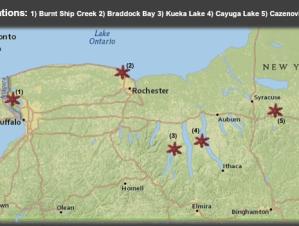

written by graduate student Alexander Krest
In last fall's newsletter, I offered an overview of the invasive macroalgae Starry Stonewort (Nitellopsis obtusa), its potential threat to WNY waterways, and our research plans moving forward. I’m happy to tell you that since that point I’ve taken a deep dive into finding out what might be some of the possible ecological impacts associated with this unique invader in Western New York.
As the previous article described, this whole project started with a chance discovery of starry stonewort within Burnt Ship Creek on Grand Island, the first documented discovery of the species in Erie County. After detection, we surveyed the rest of Grand Island and mapped its presence (Burnt Ship Creek/Woods Creek). From there, with the help of lab members and advisor Dr. Pennuto, I returned to the mouth of Burnt Ship Creek and collected 5 macroinvertebrate samples from monotypic stands of the invasive starry stonewort, a native macrophyte Canada waterweed (Elodea canadensis), and a native macroalgae, muskgrass (Chara sp.) (15 total samples). The goal of this preliminary survey was to assess whether starry stonewort stands held different macroinvertebrate assemblages when compared to stands of native macroalgae and macrophytes, with a particular interest on macroinvertebrate richness, abundance, and functional feeding group composition.
After the data was processed, I found no significant difference in macroinvertebrate richness or abundance between the three vegetation types (ANOVA not significant), although starry stonewort stands had lower genera richness than the other plant types and a greater mean abundance. Comparison of functional feeding group abundances suggested that there was a significant difference between Elodea and the macroalgae macroinvertebrate communities.
These preliminary findings led to a larger survey across five sites, sampling across a gradient of dominance by Starry Stonewort within each site. Sites range from Grand Island to Syracuse. I am also incorporating a lab study to investigate the possible impacts of starry stonewort on the reproductive capabilities and feeding rates of two target macroinvertebrate types (snails and amphipods). The second portion of my thesis, evaluating Starry Stonewort as a reproduction inhibitor or food resource will take place in the lab as a surrogate to winter surveys in natural settings.
I’m currently in the process of completing this thesis work and things are looking good so far. I hope that by the time the spring rolls around I’ll not only have some more definitive results into the ecological impacts posed by this invasive macroalgae, but also a project that provides a foundational piece of academic work for further research on the ecological impacts of this invasive macroalga.
Photo gallery: Studying invasive starry stonewort
Image caption: A map of sampling locations with representative bulbils marking each site, along with neighboring number that corresponds with the site name.
Some content on this page is saved in PDF format. To view these files, download Adobe Acrobat Reader free. If you are having trouble reading a document, request an accessible copy of the PDF or Word Document.
